NEW VIEWS VII - 2008 LITERARY BURLINGTON COUNTY
Writers, Historic Libraries, and Literary Forums
Burlington County’s role in the history of America takes many forms. The pre-colonial role of the Lenni-Lenape, the Quaker influence on the colonization and social evolution of the county, and the impact on the American Revolution both as a haven for patriots and a diversionary battlefield are legend. Not to mention the county’s place as a leader in transportation, commerce, agriculture and industry!
But how many are aware of the literary talents and contributions of Burlington County residents over the centuries? This year’s New Views will focus on several historic local libraries and literary forums and some of the lesser known literati of Burlington County. There are dozens of individuals and places in the annals of Burlington County whose contributions to the fields of poetry, literature, history and journalism deserve recognition and acclaim. To that end, we invite artists to memorialize the places associated with these writers and institutions through the visual arts.
Download the Artist Application (PDF) Here
Adobe Acrobat Reader required. Download for free here

1. The Mount Holly Library, 307 High Street, Mt. Holly. King George III first chartered this library in 1765 as the Bridgetown Library and for a time during the nineteenth century the institution also went by the name "The Burlington County Lyceum of History and Natural Science.' It is the fifth oldest library in New Jersey. The present Georgian style building dates to 1830 and once served as the mansion of James Langstaff, a wealthy farmer. It became the library’s first permanent home in 1957.
Directions: The Mount Holly Library is across the street from Sacred Heart Catholic Church on High Street, about half way between Fountain Square/Mill Race Village and the Mount Holly bypass.

2. The John Woolman Memorial, 99 Branch St., Mt. Holly – 1783 John Woolman (1721-1772) is considered the most famous American Quaker of all time. Born in the Rancocas area, Woolman became associated with the Rancocas Meeting and labored as a tailor in Mt. Holly. A noted humanitarian and abolitionist , his greatest contribution to literature was his anti-slavery Journal which he began writing in 1756. It was published posthumously and became well-known as far away as Europe. His writings included an abolitionist tract: Some Considerations on the Keeping of Negroes . He eventually persuaded the Philadelphia Society of Friends to decree that its members should not own slaves.
Alternate or integrative monument: Site of Woolman Tailor Shop – plaque at entrance to 47 Mill St., Mt. Holly.
Directions: You can access the Woolman Memorial from High St. in Mt. Holly via Garden Street (the corner marked by the Friends Meeting House). Proceed on Garden St. to the end (about half a mile). Take a sharp right onto Branch St. One-tenth of a mile on the left is a white picket fence of the John Woolman Memorial. You can also access it from Mill St. Turn left at the 7-11 store. The Woolman Memorial will be on your right.
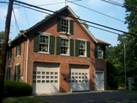
3. The Rancocas Lyceum, 203 Main St., Village of Rancocas, Westampton. Rancocas Village was, at one time, one of the most intellectual and literate areas of Burlington County. The Rancocas Lyceum Association was considered one of the finest in the county. Organized in 1860, people came from all over to hear recitals, dramatic interpretations, poetry readings , and other literary events. Shakespearean recitals were so favorably presented that the Lyceum began to be called the “Quaker Theatre.” The Lyceum was such a success that they soon realized their original space (they had been meeting in the little Rancocas School House) was too small. In 1877, they raised enough money to build a public hall with a seating capacity of 500 (which , according to historical accounts, was still a bit tight on space). This building later served as the Rancocas Firehouse from 1925 until the mid 1990s. It currently houses the headquarters of the Westampton Historical Society.
Directions: The Village of Rancocas in Westampton is located just over the border which divides it from Willingboro. It is best approached via Bridge St. (an extension of Centerton Road) off the Rancocas Bypass ( Beverly-Rancocas Road). Taking Bridge St. into the village, turn right onto Main St. #203, The Rancocas Lyceum (formerly the Fire House) is on the left next to the Rancocas Friends Meeting House.
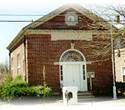
4. The Sally Stretch Keen Memorial Library, 94 Main St., Vincentown. (1923). A gift to the people of her hometown, Mary Stretch Irick Drexel (1868-1948) built and endowed the library in memory of her mother, Sally Stretch (Irick) Keen, a resident of Vincentown . The townspeople dedicated the library on June 18, 1923, with carefully planned ceremonies. It was a major social event for the quiet village of Vincentown. Mary married George W. Childs Drexel, son of Philadelphia financier Anthony Drexel. Mrs. Drexel grew up in Vincentown on an estate known as Locust Grove, located on Retreat Road, just off Route 206. She was known for her equestrian skills. In later life she became a patron of the arts in Philadelphia and Director of the Red Cross in that city. The Drexel's lived in Bryn Mar at the time of the endowment. In presenting the deed, Mrs. Drexel spoke of the great pleasure it gave her to present the Library to her hometown that she always remembered with affection. Mr. and Mrs. Drexel gave a large number of books over the years to keep folks interested in reading. Of special interest is the sunburst window over the double entrance doors.
Directions : The Sally Stretch Keen Library is located at 94 Main St., midway between Church Road and Route 206 in the Village of Vincentown. It is on the corner of Main St. and Race St. Approaching Vincentown from Rt. 206, turn onto Main St. at the WaWa. The Library is on the left, just after the bend on Main St.

5.Bellevue - the historic Gilder House, Crosswicks Street, Bordentown.Birthplace and home of Richard Watson Gilder (1844-1909), a noted poet, author and editor of Century Magazine, the house features two stages of construction. The earlier section , c. 1725, was built in the style of an English yeoman’s house, while Samuel Rodgers added the later two -story addition in 1788. The property passed to Thomas Nutt in 1814. His daughter, Jane Nutt married the Rev. William Henry Gilder, a Methodist minister who operated “ Bellevue,” a boarding school for girls in the home. William died of small-pox while ministering to ill soldiers in Virginia near the end of the Civil War. His son, Richard Gilder became sole owner of the property in 1895. Richard became the most famous Gilder. After serving in the Civil War, he became an assistant paymaster on the Camden and Amboy Railroad. He later started Newark’s first and only morning newspaper and became editor of Scribner ’s Monthly (Century Magazine). His son Rodman presented this house and the surrounding 13 acres to the City of Bordentownin 1935 to be used as a park and historic monument to the Gilder family. The house is undergoing major restoration thanks to a matching grant from the Garden State Preservation Trust Fund.
Directions: Entering historic Bordentown from Route 130 via Crosswicks Street (Rt. 528), The Gilder House and Park is immediately on the right. There is parking behind the house. If you enter Bordentown from Route 206 or 130 via Farnsworth Ave., turn right on either Burlington St. or Crosswicks St. and proceed to the end, just before these streets connect with Route 130. Gilder House is the last structure on the left.

6. The Thomas Paine House, Corner of Church St. and Farnsworth Avenue, Bordentown.Thomas Paine (1737-1809) , Pamphleteer for American Independence, and “Father of the American Revolution ,” bought this Bordentown house in 1783 and lived in it periodically until his death in 1809. Paine’s Common Sense, published in 1776 began: “These are the times that try men’s souls… .” His words and spirit heartened many a patriot in the early days of the revolution. His other works include The American Crisis (1776), Rights of Man (1791), and The Age of Reason (1793-94). The latter was his most controversial work.
Directions: The Paine House is located on the corner of Farnsworth Avenue and Church Street. It is on the left as you proceed on Farnsworth Avenue from the intersection with Route 206 or Route 130 into historic Bordentown.

7. Francis Hopkinson House, 101 Farnsworth Avenue, Bordentown Francis Hopkinson (1737-1791), one of New Jersey’s signers of the Declaration of Independence was a man of extraordinary talent and charm. He was the first scholar and first Graduate of the College of Philadelphia. He studied Law both in America and Europe. He composed music, poetry , and satire. His notable works include A Pretty Story, a skeptical examination of the relationship between Great Britain and the colonies, and Battle of the Kegs, a sarcastic taunting of the British forces occupying Philadelphia.
Directions: The Hopkinson House is on the far end of Farnsworth Avenue, not far from the Delaware River. Driving on Farnsworth from Route 130, the house is #101, on the right at the corner of Farnsworth and Park.

8. Old St. Mary’s Episcopal Church, W. Broad Street, Burlington. The oldest Episcopal Church in New Jersey (1703). The architecture and landscaping of St. Mary’s Church displays the sensibilities of Burlington’s early adherents to the Church of England. During the American Revolution, this church served as the focal point of the activities of the American Loyalists. Reverend Jonathan O’Dell worked diligently from the pulpit and penned rhythmic Tory poetry and songs to convince people that King George III was the rightful ruler of America, until his own expulsion from the new nation.
Directions: Entering the City of Burlington from Route 130 via High Street, proceed to Broad Street. Turn left and continue to Wood St . Old St. Mary’s is the cream stucco structure on the far corner (not to be confused with “New St. Mary’s”, the stone church with the steeple).

9. The Library Company of Burlington, 23 West Union St., Burlington. King George II chartered this library in 1757 for founder Thomas Rodman and John Reading. It is the oldest library in continuous operation in New Jersey, and the 7 th oldest in the United States. The first patron was William Franklin, son of Benjamin Franklin. T oday the library still houses many of its original volumes from the eighteenth century.
Directions:Entering the City of Burlington from Route 130 via High Street, proceed to Broad Street. Turn left and continue to Wood St . Turn right on Wood St. and proceed to West Union St. Turn right. The Library Company of Burlington is mid-block on the left.

10. The Collins Jones House, northeast corner of Broad and York Streets, Burlington. The Crown appointed Isaac Collins as His Majesty’s Royal Printer in 1770 and he proceeded to furnish the colony with three -pound notes. He started the first newspaper in New Jersey which he titled ,The New Jersey Gazette. In 1777, Collins began publish ing The Gazette in Burlington , but after producing several editions there, Collins moved his printing press to Trenton. Many of his editorials criticized local leaders and his reputation for honesty made him an influential force.
Directions: Entering the City of Burlington from Route 130 via High Street, proceed to Broad Street. Turn right and continue for two blocks to York. The Collins-Jones house is on the far left corner of Broad and York.
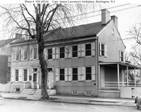
11. Birthplace of James Fennimore Cooper. 457 High St., Burlington. The Cooper House was the birthplace of America’s first true novelist, James Fenimore Cooper, author of The Last of the Mohicans , Leatherstocking Stories , and numerous other books about the American Wilderness. Part of the Burlington County Historical Society complex, it is adjacent to the Lawrence House. Observing the structure from High St reet, The Cooper House is on the left; the Lawrence House on the right.
Directions: Easily accessible from Route 130. Proceed into Burlington on High Street. The Cooper House is on the right midway between Route 130 and Broad Street, Burlington.

12. Stephen W. Meader home, 565 East Main Street, Moorestown. Author of Children’s Books (1892-1977) . Stephen Meader, born to Quaker parents, wrote his first children’s book, The Black Buccaneer , in 1920. H e moved his growing family to Moorestown in 1922 and by 1927, he had obtained a position with the Philadelphia advertising firm of N.W. Ayer & Son. Meader published his second book in 1934: Down the Big River. He quickly became a prolific writer of children’s books , totaling 20 volumes and many short stories and poems. His works includ e some stories with a New Jersey or Burlington County theme, including Cape May Packet and Shadow in the Pines. Among his most widely known books was T-Model Tommy . Many of these books are currently being reprinted. During his life in Moorestown, Meader served as the President of the Moorestown Free Library trustees from 1937 through 1963. At the time of his death in 1977, he resided in Cape May Courthouse, New Jersey. The Meader home is currently owned by Robert and Camille West. It is over 100 years old and has undergone extensive renovation in recent years.
Directions: The Meader home ( #565 East Main St.) is located on the eastern end of Moorestown near Marter Avenue. It is on the north side of Main Street midway between Poplar and Pancoast Streets.
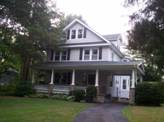
13. George DeCou residence, 3 West Maple Avenue at the northwest corner of Maple and Mill in Moorestown.George DeCou (1867-1950), wrote numerous history books and pamphlets on Moorestown, Burlington County , and South Jersey: Moorestown and Her Neighbors (1929 and 1952); Burlington: A Provincial Capital (1945); The Historic Rancocas (1949); and pamphlets on other Burlington County communities. DeCou became President of the Ramblers, a popular Moorestown literary society in 1899 and again in 1914. Over his lifetime he lived in different parts of Moorestown, but his primary residence, built in American Vernacular style, still stands at 3 West Maple Street. DeCou designed and had the home built in 1912. He and his family lived here until 1931. The current occupants, Mr. & Mrs. James Delaney, purchased the home in 1976 from the Winston Family.
Directions: Access Maple Avenue via Chester Avenue (Route 603) in Moorestown. Maple is midway between Main St. and Bridgeboro Road. Going south from Bridgeboro Rd., turn right onto West Maple; going north from Main St., turn left onto West Maple. Proceed to Mill Street. #3 is on the northwest corner of Maple and Mill.

14. Office of Dr. James Still (1812-1885), 209 Church Road (Rt. 616), Medford. Dr. James Still’s life is an amazing tale of the son of former slaves growing up in extreme poverty and becoming one of New Jersey’s earliest medical doctors. He was one of 18 children of slave parents. Dr. Still was a distinguished herbalist at a time when most doctors relied on often questionable, patent medicines. Called “The Black Doctor of the Pines,” he had a large biracial practice. He also distinguished himself as a spokesman for the black community of South Jersey. The Medford Historical Society has reprinted his autobiography: “Early Recollections and Life of Dr. James Still” (1877). The work chronicles the African-American experience in Burlington County before, during, and after the Civil War. The State of New Jersey, Burlington County, and Medford Township, New Jersey agreed in 2006 to preserve Doctor Still’s office and property as part of the New Jersey’s Green Acres program. Plans are being finalized to restore the office as a museum.
Directions: Dr. Still’s office is located at what was known as “Crossroads” – the intersection of Church Road (Rt. 616) and Medford-Mt. Holly Road (Rt. 541), on the opposite corner from the WaWa convenience store. There is a historical marker at the site. Access Medford-Mt. Holly Road from the former Medford Circle on Route 70.
Alternate and integrative monument: Dr. Still’s tomb is located in the graveyard behind Jacob’s Chapel on Elbo Lane in Mt. Laurel, just off of Mt. Laurel Road.
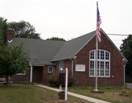
15.The Beverly Free Library, 443 Cooper St. Beverly. Built in 1929, the Beverly Library grew out of the Beverly Paragraph Club, a literary organization formed in 1895. The Paragraph Club bought the ground for the library after selling a plot of land along Warren Street given to them to build a clubhouse. The library first started about 1911 with club members and other local residents supplying many of the original books. The original club disbanded in 1930, but a new Paragraph Club organized in December 1946. On the front lawn there is a monument indicating that the library building is a memorial to the men who served in World War I; a plaque at the foot of the flagpole in memory of David Weiss, “Patriot and Philanthropist”, 1889-1967; and a marble bench honoring Elaine M. Curtin, Library Director from 1975 through 1997.
Directions: The City of Beverly can be accessed from Route 130 via Cooper St. in Edgewater Park ( Cooper St. is an extension of Charleston Road in Willingboro). The library is on the left as you near the end of Cooper Street where it meets at “5 corners”, the major intersection in the center of Beverly. Accessing Beverly from Rt. 130 on Beverly Road, just below the Burlington Bristol Bridge access road, take Beverly Road to “5 corners”, turning left onto Cooper St. The library is on the right, next to a Pharmacy.
 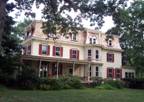
16. Taylor Wildlife Preserve - Riverside Homestead Farm, #7 Taylor’s Lane, Cinnaminson.Residence of Mary Roberts Taylor (1888-1980)and Joseph Taylor (1914-1991).In a 1975 memoir, “Gently Sister Gently,” Mary Roberts Taylor chronicled her life as a Quaker farm wife and mother. May, as the family knew her, was born Oak St. in Moorestown and spent her youth between Moorestown and Atlantic City (her father owned the Chalfont Hotel). She married Howard Taylor and moved to the Cinnaminson farm. The Taylor family owned and worked this property for generations since the 1700s. May’s son, Joseph, a teacher by profession, moved back to the family farm in 1948. Under Joseph Taylor’s leadership, the family put into action their land stewardship ethic by giving up their development rights on 89 acres of their farm through a permanent open -space easement under the New Jersey Natural Lands Trust. Joseph Taylor’s contribution to journalism (and to environmental research) was “The Cinnaminson Waterfront Today and Yesterday – The Current State of the Riverfront on the Delaware with an Environmental and Land Use History of the Area” (1988). Taylor family members still reside in adjacent historic riverside mansions on the property. Kitty Taylor Mizuno, one of Joseph’s daughters, lives in #7, the family home of Mary Roberts Taylor, built in 3 stages (mid-1700s, mid -1800s , and 1886. Next door, at #3, Suzanne Day, who married Harold Taylor, lives in the 1886 home of Joseph Taylor’s grandparents. Both homes have unique Second Empire-style Mansard roofs. Either home, including flora and fauna are acceptable candidates for the New Views art project.
Directions: Using Route 130, turn onto Taylor’s Lane towards the Delaware River ( Taylor’s Lane parallels the dividing line between Delran and Cinnaminson). Proceed to the traffic signal at River Road (Hoeganaes Corporation is on the left). Cross directly over River Road onto the dirt road which meanders through Taylor Wildlife Preserve. Continue towards the riverfront for half a mile, bearing left at #13, following signs to the vegetable stand. The green and white house, a section dating back to the mid 1700s, was the home of both May Taylor and also of her son, Joseph. The yellow house next door is the 1886 Taylor home.
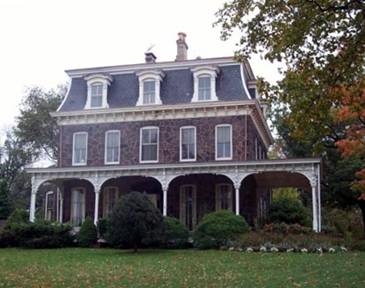
17. Mary Biddle Fitler Home, 201 Bank Avenue, Riverton. Mary Biddle Fitler (c. 1878-1966) spent her life before her marriage to N. Myers Fitler in this home. Author of novels for youth, she wrote a total of four books, all centered in Riverton: Reddy (1929), which broke all records for sales and went into 10 printings; Kid (1930), a sequel to Reddy; Anna Mary, A Girl of the Nineties (1931); and The Big Wharf (1934). Her books brought untold pleasure to the children enduring the Great Depression and all of these books are highly prized collectible volumes today. Following her husband’s death, Mrs. Fitler relocated to Wynnewood, Pennsylvania and she summered in Beach Haven, New Jersey.
This home is a beautiful Second-Empire uncoursed brownstone complete with a concave mansard roof featuring fishscale slate shingles and round top dormers. Constructed circa 1876, this house served as the home of the Henry C. Biddle family from its completion and remained in the Biddle family well into the twentieth century. Mary's brother, H. Mcllvain Biddle, resided there after the death of their parents. He served as mayor of Riverton for some years. Some people consider this Biddle house to be one of the finest examples of Second Empire architecture in Burlington County. Notice the decorative cornice brackets; the very narrow surrounds on each side of the dor, along the transom; the floor-length windows fronting the porch; and the graceful trim under the porch cornice. (Architectural notes courtesy of Paul W. Schopp).
Directions: Following Broad Street along the River Line in Riverton, turn onto Lippincott Ave. towards the Delaware River. At the end of Lippincott Ave., turn left onto Bank and proceed to #201, located on the north corner of Thomas Avenue -- the home where Mary Biddle Fitler grew up.
JML 8-7-07 Rev. 10/27/07
|